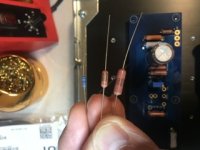I’m wondering why a 10k ohm 1/4 watt resistor is so much larger than a 3k3 ohm 1/4 watt? They are both metal film, one is dale and I’m not sure what the other is. Take a look at the picture and tell me what you think. These are both from mouser and the part numbers correspond to the part but Why the 3300 ohm is so much smaller than the 10k is odd, to me. I’ve got 18 ohm 1/4 watt that are physically bigger. What’s the deal?
Thanks
Thanks
Attachments
Manufacturers have their processes that they use for manufacturing a specific part. Sometimes that just involves a different method for one thing compared to the other despite the same technology being used.
I think he has a valid question. Typically, higher power cylinder resistors are physically larger. I have seen similar cases, and have always wondered why some have the same rating yet are twice as small (or large).
Maybe the answer is that the smaller resistors can operate at a higher temperature, and the data sheet should show that. If so, I wonder what that does to stability; do the smaller/higher temp also have lower tempco's? Then they should be more expensive..
Jan
Maybe the answer is that the smaller resistors can operate at a higher temperature, and the data sheet should show that. If so, I wonder what that does to stability; do the smaller/higher temp also have lower tempco's? Then they should be more expensive..
Jan
So, the first question is what does the power rating MEAN? (Hint; see data sheet)
Run at x% above rated power, does the component change value by y%; discolour a little; release its magic smoke; glow red; vaporise; etc.
What conditions pertain to the rated value? Ambient temp, airflow, adjacent pcbs.
Etc., Etc.
Run at x% above rated power, does the component change value by y%; discolour a little; release its magic smoke; glow red; vaporise; etc.
What conditions pertain to the rated value? Ambient temp, airflow, adjacent pcbs.
Etc., Etc.
A larger resistor body has more surface area which allows more heat dissipation. So for the same model of resistor, the larger one can have a larger power rating, but not always. If a smaller surface area one can withstand operating at a higher temperature due to the material it is made of, then it could have a higher power rating than a larger one not so endowed. Best thing is to look up the mfr spec.
Yes. Normally the data sheet would say what the PCB track diameter/thickness is for the indicated delta-T, in still air. Thus there is heat loss through the air by convection and radiation as well as conduction via the PCB tracks.
Jan
Jan
Very simple 🙂 I can't really see the markings in the picture, but I think this is the only problem.
Attachments
Last edited:
- Home
- Design & Build
- Construction Tips
- Resistor size

